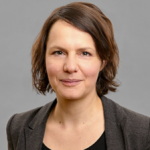“Knowledge does not mean ability.” Students may know a lot in theory about working as a teacher, about counseling interviews, about assessment centers or about negotiating, but at the same time have few skills and abilities in these areas. Their knowledge does not inevitably go hand in hand with the ability to analyze situations appropriately, select alternative courses of action in a considered manner, make an appropriate decision and then evaluate and reflect on it. However, it is precisely this systematic approach that characterizes professional and competent action.
competent action.
In order to act effectively in this way, extensive and well-networked structures of so-called conceptual knowledge are required. Conceptual knowledge integrates declarative and procedural knowledge. The former describes knowledge about facts, content or objects (knowing what), the latter describes the ability to carry out sequences of actions in a targeted and effective manner (knowing how). It is inevitably clear that procedural knowledge draws on existing declarative knowledge. In order to build a networked knowledge base, ‘knowledge’ and ‘ability’ cannot therefore be categorically separated from one another.
Rather, they are interrelated learning objectives that should be addressed effectively in terms of didactics and methodology in university teaching. Courses should create concrete opportunities for action that are designed in such a way that elaborate cognitive processes can also take place alongside pure situational management.
This is just one of the challenges that has established itself as a perennial argument in the higher education landscape in recent years under the call for a stronger ‘theory-practice link’. It is no coincidence that the current discourse on the future of universities in general is characterized by the demand for more action-oriented studies and, in particular, for the concrete use of, for example, case work, simulations, role plays, microteaching or videography in teaching.
The fact that the majority of courses nevertheless focus almost exclusively on the acquisition of declarative knowledge
declarative knowledge and that there is usually no productive link to the practical application situation has been proven both empirically and anecdotally. This critical assessment does not go unnoticed by the teaching target group. Students emphasize what they see as the lack of relevance of course content and theories for their later professional activities. This relevance problem is seen by many students as the main reason for a high perceived study load. At the same time, from the students’ perspective, refraining from critically reflecting on course content and contexts seems to have established itself as an effective strategy to counteract this stress-inducing factor. This leads to the formation of ‘inert knowledge’ which, although understood in abstract terms, cannot be used constructively to solve problems professionally and competently.
The ongoing digitalization of university teaching now offers various innovative teaching and learning methods that are able to reduce these gaps in knowledge and skills. (Digital) alternatives are becoming an increasingly important learning element for linking theory and practice and gaining initial practical experience. A key driver of this development is the adaptation of new technological developments and devices for learning and educational purposes. They open up new didactic and methodological approaches and thus opportunities for university teaching.
One of these promising future technologies is virtual reality (VR). VR is defined as a medium that provides realistic or unrealistic situations in synthetic, interactive, three-dimensional, spatial environments with the help of various accompanying technologies. Even though VR has been usable as a technology since the 1990s, it has become significantly more attractive for use in teaching-learning arrangements due to the rapid technical development over the past five years in terms of visualization and interaction. It is above all the further development of head-mounted displays (HMDs), such as the Valve Index or Oculus Quest 2, that has made VR socially acceptable and brought it into the homes of many people. With its visual, auditory and kinaesthetic access, VR ensures that information from the real world is replaced by information from the virtual world. Users experience a feeling of immersion, i.e. a correspondingly high level of sensory perception that pushes the perception of real reality so far back that the physical environment and objects of the real world are no longer perceived.
In the research context, the discourse on the educational potential of VR has increased significantly in recent years. Various studies and research projects now attest to the educational benefits of the technology. This goes
to the extent that VR has already been chosen by some educational stakeholders as ‘the’ learning aid of the 21st century. For example, VR can prove to be beneficial for increasing self-efficacy, as a tool for reflection, for the three-dimensional visualization of learning objects or even for the acquisition of a networked knowledge base and offer added value compared to established approaches.
The sub-project picks up on the increasing use of virtual reality in the university context and pursues the sustainable implementation and further development of the technology for the entire university. In future, VR will enable Leuphana students to immerse themselves in controlled, computer-programmed, interactive environments in a protected environment. Here they can realistically expand their declarative knowledge with elements of procedural knowledge and acquire theory-based practical skills. The technology also offers great potential for intensive reflection with fellow students, lecturers and experts.
As an interdisciplinary project, two thematic approaches are pursued with regard to the application of VR. Students are to be trained in (1) their applied competencies and skills as teachers and advisors in the school context (cf. Huang et al., 2020) and (2) their negotiation skills as applicants in assessment centers (cf. Loschelder et al., 2016a, 2016b). The project is also pursuing two technological development steps. In the first step, VR technology is being tested in combination with 3D360° recordings. The second development stage involves the development of realistic and interactive VR training modules using the Unreal Engine or Unity3D. The Oculus Quest 2 will be used as the HMD in both development stages.
used in both development stages. The immersion in the VR environment and the associated increased realism of the situation experienced, e.g. in comparison to role-playing games with
compared to role-playing games with fellow students or written case studies, students can gain their own experience in
practical use cases and are thus better prepared for real-life future scenarios, e.g. the preparatory service or the first salary negotiation.
The long-term goal is to train Leuphana students (1) from the teaching degree program (> 1.100) in their own teaching and consulting activities through consecutive, realistic VR training modules and (2) to train all interested Leuphana graduates throughout the university (especially in the disciplines of management, psychology, economics, law, etc.) in negotiation skills and prepare them for salary negotiations and assessment centers. The core components of the respective VR training modules are the active practice of behavior in virtual space and a pronounced reflection phase, including (peer) feedback and development impulses.
The sub-project is structured along five successive phases:
- First, challenging situations from everyday teaching (classroom management and consultations) as well as success factors in salary negotiations are identified and classified according to their difficulty.
- Based on these results, realistic training situations are scripted and filmed using a 3D360° camera and with a cooperating practice partner. Virtual training modules including interactions are programmed
- The seminar concepts, including reflection elements and peer feedback formats, are developed didactically and implemented digitally.
- The VR training modules are piloted, tested, evaluated and revised with around 15 students from both disciplines.
- An evaluation will be carried out with around 100 students and a comparison will be made between the teaching, consulting and negotiation skills of the VR participants with (a) a classic control group that goes through the regular, analogue Leuphana course of study, and (b) a comparison group, which is trained via video (see sub-project Prof. Kleinknecht).
After the evaluation phase and effectiveness review, both training elements should be made available to all teacher training students (Training 1) or to all graduates at Leuphana (Training 2) and included in the respective curricula. The aim is to achieve an above-average quality in the teaching and negotiation skills of VR training graduates, and to expand and strengthen the opportunities for digitally based skills transfer at Leuphana in an interdisciplinary and cross-faculty manner.





